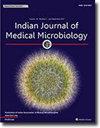Molecular characterization of methicillin-resistant Staphylococcus aureus: Dissemination of multidrug-resistant community-associated MRSA and emergence of LA-MRSA, in a healthcare setting
IF 1.4
4区 医学
Q4 IMMUNOLOGY
引用次数: 0
Abstract
Background
Methicillin-resistant Staphylococcus aureus (MRSA) continues to be a significant cause of healthcare-associated infections (HAIs). In this study, we aimed to characterize the MRSA isolates obtained from HAIs.
Methods
A total of 200 clinical and 13 nasal MRSA isolates were collected and tested. The samples were analyzed for SCCmec typing by using multiplex PCR. Microtiter for biofilm formation were performed and molecular typing for the samples were performed for spa and agr typing.
Results
The isolates showed 100 % sensitivity to vancomycin and linezolid, while 92.5 % were multidrug-resistant. Strong biofilm-forming ability was observed in 47 % of the isolates. SCC mec typing identified 52.5 % of the isolates as classical hospital-associated MRSA or HA-MRSA (SCC mec type III), 23.5 % as community-associated MRSA or CA-MRSA (type IV and V), and 16.5 % as non-typeable, with 7.5 % having multiple SCCmec types.
Conclusion
Comparison of HA and CA-MRSA traits revealed that both groups had multidrug resistance, but HA-MRSA was distinguished by its strong capacity for biofilm formation, whereas CA-MRSA was marked by a high count of toxin gene. Our study, to the best of our awareness, documents the presence of LA-MRSA (SCCmec V- t127-agr III) causing HAIs in Indian patients for the first time.
耐甲氧西林金黄色葡萄球菌的分子特征:多药耐药社区相关MRSA的传播和LA-MRSA的出现。
背景:耐甲氧西林金黄色葡萄球菌(MRSA)仍然是医疗保健相关感染(HAIs)的一个重要原因。在这项研究中,我们的目的是表征从HAIs获得的MRSA分离株。方法:收集200株临床分离株和13株鼻腔MRSA分离株进行检测。采用多重pcr对样本进行SCCmec分型分析。采用微滴法测定生物膜的形成,并对样品进行spa和agr分型。结果:该菌株对万古霉素和利奈唑胺的敏感性为100%,耐多药率为92.5%。47%的菌株具有较强的生物膜形成能力。SCCmec分型确定52.5%的分离株为典型的医院相关性MRSA或HA-MRSA (SCC mec III型),23.5%为社区相关性MRSA或CA-MRSA (IV型和V型),16.5%为不可分型,7.5%为多种SCCmec类型。结论:比较HA和CA-MRSA的性状,发现两组均有多药耐药,但HA- mrsa的特点是生物膜形成能力强,CA-MRSA的特点是毒素基因计数高。据我们所知,我们的研究首次记录了LA-MRSA (SCCmec V- t127- agr III)在印度患者中引起HAIs的存在。
本文章由计算机程序翻译,如有差异,请以英文原文为准。
求助全文
约1分钟内获得全文
求助全文
来源期刊

Indian Journal of Medical Microbiology
IMMUNOLOGY-
CiteScore
2.20
自引率
0.00%
发文量
154
审稿时长
73 days
期刊介绍:
Manuscripts of high standard in the form of original research, multicentric studies, meta analysis, are accepted. Current reports can be submitted as brief communications. Case reports must include review of current literature, clinical details, outcome and follow up. Letters to the editor must be a comment on or pertain to a manuscript already published in the IJMM or in relation to preliminary communication of a larger study.
Review articles, Special Articles or Guest Editorials are accepted on invitation.
 求助内容:
求助内容: 应助结果提醒方式:
应助结果提醒方式:


